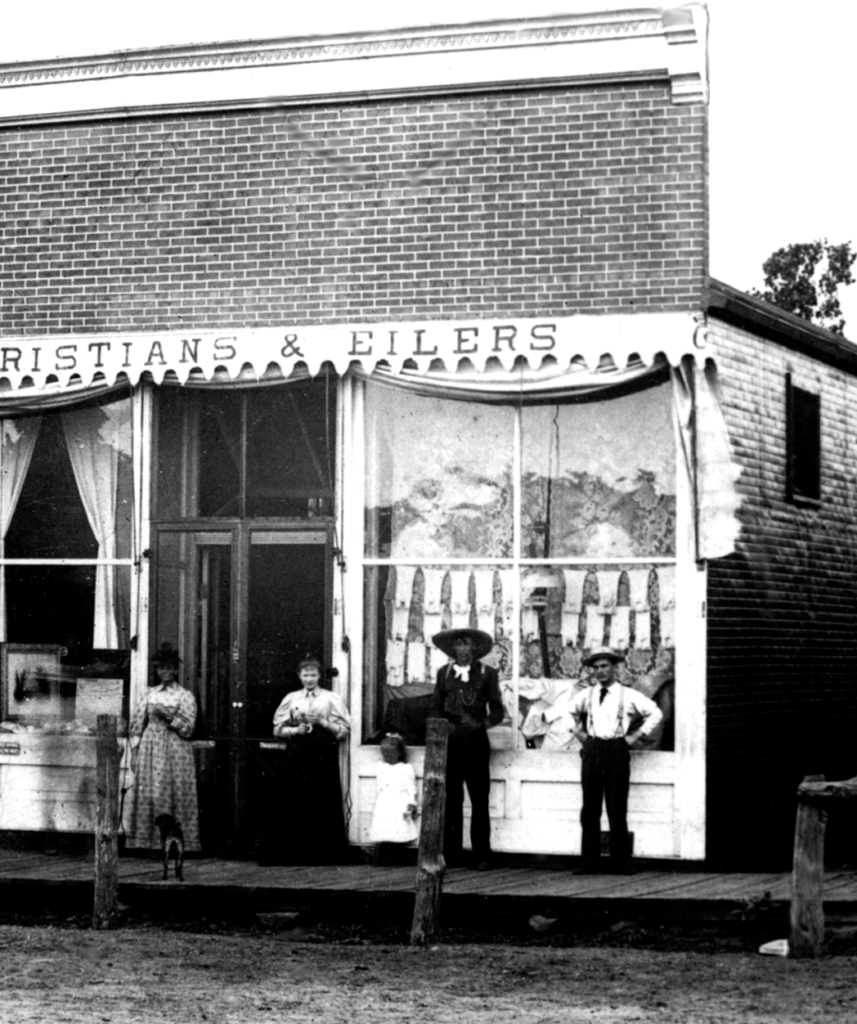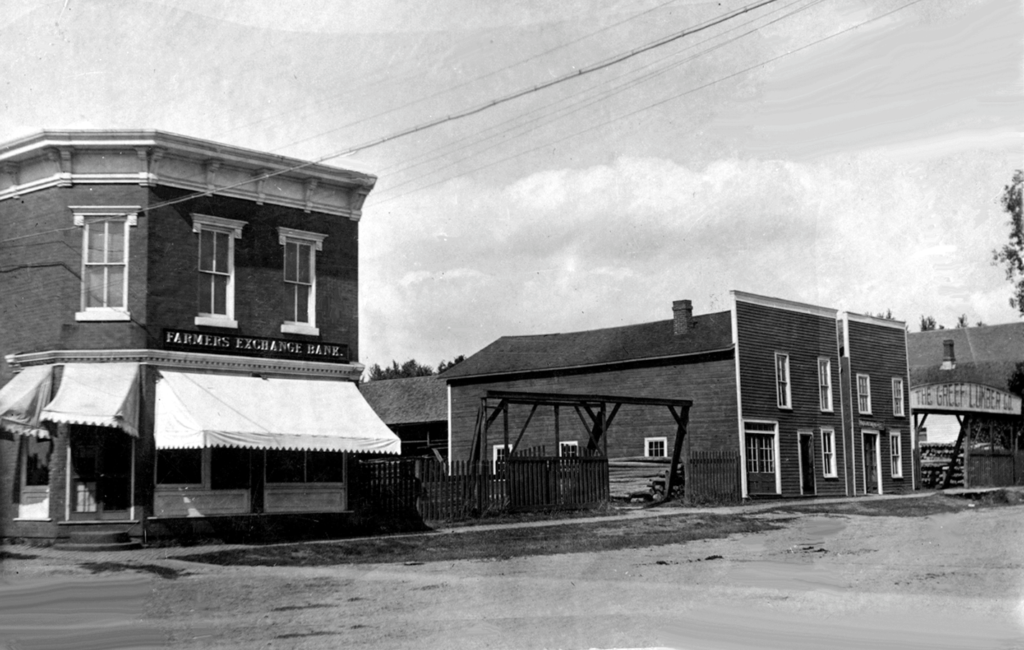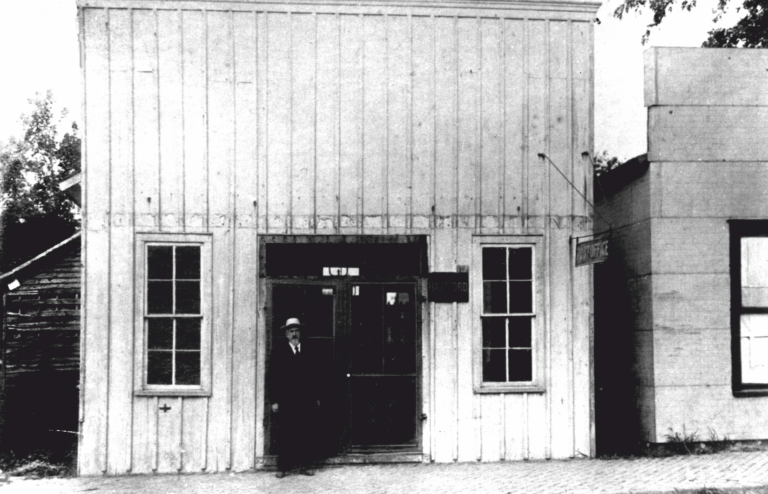
SRHS
Steamboat Rock Historical Society
A CENTURY DRAWS TO A CLOSE
As the Century drew to a close, Steamboat Rock was 45 years old. And an amazing 45 years it was. From a wilderness on the edge of civilization a town had grown. Hard working people in trying to build a life for themselves had made a town.
Businesses, schools, farms, and churches soon stood where few had walked 50 years earlier. The railroad had come and it brought growth that was beyond anyone’s dreams.
Hundreds had come. Some moved on but many remained. Immigration from Germany brought the greatest number of new faces along with customs, and new determination to succeed. Coming with status of European peasant they soon shed that destiny of the old country. Dress, language, circles of acquaintance, politics, lodges, the common interests in roads and schools, farm organizations–a thousand things gradually began to be shared with those who had arrived earlier. Quickly these “Immigrants” were as American as the rest. In no time at all they were merchants, farmers, ministers and teachers.
A period of lawlessness prevailed for a time, but it too had passed and life had settled down to a tranquility that perhaps reveled that of the earlier time.
As the new century drew near, there must have been an overwhelming excitement as the community leaders planned for the future.
Those contemplating the future for the town at the end of the 19th Century were all men who would be heard from frequently in the new era. Elda Christians (German by birth) was mayor. The members of the town council were D.W. Turner, Frank Carpenter, Frank DeGroff, W.D. Meredith, C. R. Green and Thomas E. Gearhart.
Township officers were Henry Luiken (German) and A.A. Leverton, justices of the peace, A.A. Jaspers (German), constable, R.S. Wardwell assessor. Trustees were D.W. Turner, J. H. Hoover and F.H. Sterns, and Henry Luiken was clerk.

Those who came from Germany came first for farmland. They were followed by the tradesman. Tinsmiths, harness makers, shoemakers, to name a few. Growth prompted others to go into business as well. In 1894, Elda Christians and Fred W. Eilers moved a stock of goods from Cleves and built a new building on the north side of Market street adjoining the Williamson & Lepley general store to the east. These two buildings of stock were later consolidated and made one building.
Fred Eilers sold his interest to Elde Christians; a few years later and went into the implement and furniture business, businesses that would not have been possible before the railroad. The general store was then known simply as E. Christians.
In 1888, after ten years of operation Thomas Neesen closed the creamery, and sold some of the machinery and equipment. There would not be a creamery in Steamboat Rock for the next twelve years.
William Fred Asher, his wife, Caroline, his son William Charles, and daughter, Amanda (Mrs. John Luiken) came to Steamboat Rock in the year 1889, from Freeport, Illinois. They settled three miles southeast of Steamboat Rock. It is thought that he may have purchased some of the Neesen creamery equipment because he operated a creamery on his farm, churning by the use of horse power. He stored his butter in a deep well, keeping it cool and fresh.
Neesen’s mercantile business had continued through the period that his creamery was in operation and he now devoted his time to his merchandise business until 1897, when his son Walter took over the men’s clothing and shoe business. The elder Neesen had decided to move on and set up a new store in Lawn Hill. However in less than a year he had returned to Steamboat Rock.
The general store was changing mostly in that they now carried a wider array of merchandise, and had a more stable ownership. The new pioneers were arriving by train, and not with wagons of goods. Merchandise now came by railroad as well, and new products were coming. Products never before heard of plus beautiful fabrics, and more ready to wear. Tools, implements and fruits like oranges, and bananas which had never been seen by many of the citizens. What a treat! Those now in the business chose to remain in the business for a longer period, and not just as a step to another vocation.
In addition to the mercantile of Thomas Neesen which had been in business since 1868, there were nine others that began their businesses before the turn of the century and some remained only a short time, but many prevailed into the new century. They point out growth and prosperity that the town was still enjoying.
In January of 1897 D.W. Turner sold his lumber business on Market Street to the Greef-Esgan Lumber Co. of Eldora who took possession Feb. 1.

T. H. Dickey of Temple Texas formerly of Steamboat Rock, came back to take charge of the lumber yard for the new owners. Greef-Esgen Lumber Co.
The Root Hotel on Main Street was sold in January of 1897 to a Mr. Jackson. A.S. Root who had started the business nearly 40 years earlier, continued to run the free bus for them. The free bus was a horse drawn affair that was used to transport people from the depot to the hotel and back again.
Also in 1897, the Street Commissioner (Kurt Cable) was busy clearing Main Street of hitching posts.
Blacksmiths were still in demand. There were four operating in Steamboat in 1897. S. W. Wilson Blacksmith, had a shop in Wellsburg and Steamboat but sold his shop in Wellsburg to give full time to his Steamboat Shop. At the same time J.R. Edick and sons were building a new Blacksmith shop in town.
Albert VanDornum was also building a new Blacksmith shop at their place east of town.
All three were in addition to the former VanDornum shop which was now owned and operated by William Hartman.
Mr. McLean, Miller was operating the Lathrop mill, (S.F. Lathrop had died) still turning out a superior grade of flour running day and night to keep up with trade.
Wheat was longer being grown in the area but was shipped in on the train. So fine was the product produced by the local Lathrop mill that it was still economical to do so.
That winter an ice jam did some slight damage to the dam, which was thought at first, might force a shutdown of the mill. Fortunately that did not happen.
Farming was good too. One article indicated that Carl Hass hauled 11 loads of hogs to buyers in Eldora. It went on to state that the lot weighed nearly 15,000 lbs.
Not all was good as some businesses did close. Hilko Swyter who had a jewelry store on Market Street for 3 years closed and moved to Aplington. He was surely missed because he had organized the B.Y.P.U. at the German Baptist Church and had worked among the youth.
Berend Eilers who had a shoe shop in the building occupied by Hilko Swyter was forced to move on the closing. He moved into the D. W. Turner building 1 door west of the Brown’s Barber Shop. Not too long after he closed up altogether and moved to Fort Dodge and operated a small shop in his son Dick’s hotel there.
Two new businesses appeared in Steamboat Rock in 1897. Both independent of one another but were operated by brothers. F. W. Eilers started a chicken hatchery In 1897, and his brother John Eilers began a corn shelling business. Both were obviously businesses that catered to agriculture.
A new restaurant was opened by Chas Gellhorn and Edick on the south side of Market Street opposite the post office.
An article in the Echo stated, “Charles Gearhart is chief cook at the Gellhorn restaurant. They say he can put up as nice a dish as anyone.”
It was later noted that Mr. Gellhorn got all the restaurant business in town because he provided them with piano music. Sometime after Gellhorn gave music lessons in town and did piano tuning.
Henry Luiken became postmaster for a second time in ‘97. The post office still stood in its original location across the street west of the present bank. In 1897, he had the post office moved to a building where the town’s last barber shop stood just west of where the town library now stands.

The Post Office was moved in 1897. Here Henry Luiken, Postmaster, is standing in front.
© 2020 Steamboat Rock Historical Society | All Rights Reserved
Powered by Hawth Productions, LLC